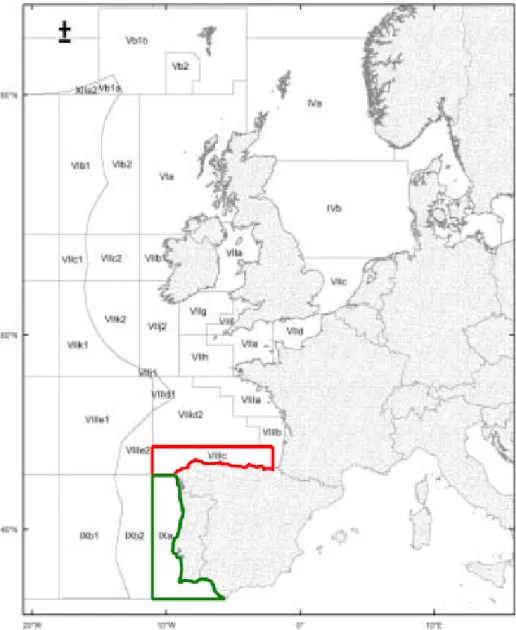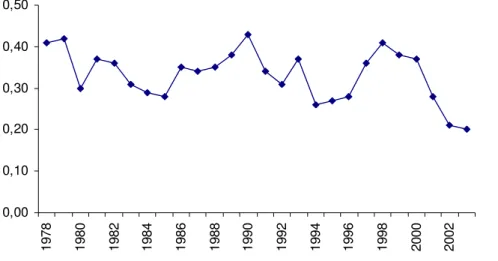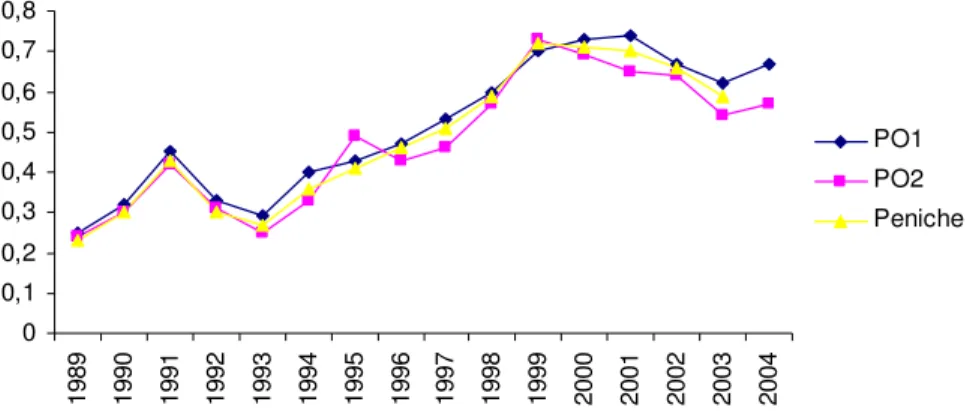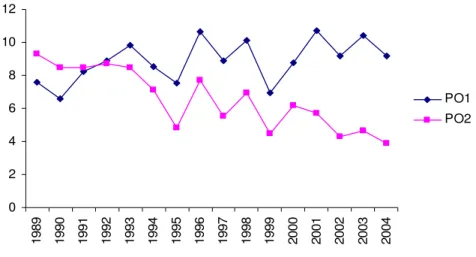Volume 2, Issue 1, 2008
The Drama of the Commons. An application of Cournot-Nash Model to the Sardine in Portuguese waters. The effects of collusion
José António Filipe, Assistant Professor, ISCTE Business School, jose.filipe@iscte.pt Manuel A. M. Ferreira, Full Professor, ISCTE Business School, manuel.ferreira@iscte.pt Manuel Coelho, Assistant Professor, ISEG/UTL, coelho@iseg.utl.pt
Abstract
We study the results of collusion between two Portuguese fishing producers’ organizations (POs), with game theory. The problem is seen from a “commons” perspective, studying sardine stocks. A Cournot-Nash model is used and it evidences the benefits of collusion.
Introduction
Nowadays commons are a very important issue when we intend to analyze the resources on Earth. In the last decades international organisms related with commons have searched for good solutions to the exploitation of natural resources and to the environment.
Hardin’s publication of “The tragedy of the commons” (Hardin, 1968) was a reference for the problems that traditionally occur in the natural resources area. The essence of the problem is that resources are over-exploited because agents want to have the maximum benefits as a
consequence of a selfish human behavior.
Hardin proposed several measures to preserve resources from over-exploitation. He proposed, for example, the privatization of resources or the implementation of coercive measures. We may say that it is important to implement several rules to avoid tragedies and that the collusion between agents is an important instrument to reach this aim. This means that if there is collusion (among all the agents who exploit the resource and the agents who rule or coordinate resources exploitation) the given resource is prone to be well managed, to be well regulated and to be well preserved. This will allow high prices in the market for a given resource. And, for instance, in the Portuguese sardine fisheries case, it allows high levels for fishers’ rents through low catches (or a reduced exploitation of the resource).
Our paper intends to discuss the advantages of collusion and how collusion and regulation may contribute to have high levels for Portuguese sardine stocks and to have high rents for fishers. After giving an overview, to show why collusion seems to be important to bring up good results to fishing common pools, we present a Cournot-Nash model to explain the competing agents’ behavior and the role of collusion in fisheries. We can see that collusion brings up procedures that allow the preservation of species and stocks recover. After that we discuss the Portuguese sardine fishery case and we present the main conclusions.
A brief characterization of Portuguese Sardine caught by POs
It's possible to catch Portuguese sardine along all Portuguese continental coast. Portuguese Sardine is included in the specie scientifically known as Sardina Pilchardus Walbaum and more specifically it is included in the Ibero-Atlantic stock. Its geographical limits are, in the North, the frontier between France and Spain and, in the South, Gibraltar. This area corresponds to the VIIIc and IXa divisions of ICES (see figure 1).
Figure 1: ICES VIIIc and IXa Delimited Divisions
The two POs studied cooperate closely with each other, intending to benefit from the collusion in sardine fisheries. Both POs studied fish this specie not far from the coast and not far from Peniche. Peniche is a Portuguese town, whose development has been supported by fishing activities. It is a harbor located on a peninsula, in a western region in the center of Portuguese territory. Sardine fishing has been traditionally the main activity at Peniche. However, it has declined slowly since the prosperous fifties. While in 1986 there were still more than 55 sardine boats, ten years later the fishing fleet has shrunk to half this size. Nowadays, Peniche is far from that crisis and has tried the diversification within the branch, with important results.
Cournot-Nash Model
The usual model (an oligopoly model) allows us to determine simultaneously the quantities produced by a few number of companies. Our model intends to study two POs, whose members
produce a homogeneous product (sardine). Captures of sardine are the quantities used in the traditional Cournot model.
When we consider two POs, producing sardine (considered here as a homogeneous product) and selling it in the same market, they will try to maximize their own profits (their own rewards in the game).
In the usual fishing theories, there is a variable representing quantities having a formal
relationship with fishing effort. We will use the Cournot model replacing the variable “quantities” (“catches”) by the variable “fishing effort”, respectively called q and E.
Our aim is to analyze if there is a direct relationship between fishing effort and collusion, in order to study if lower levels for fishing effort induce more conservative politics for species, more sustainable resources and better rents for fishers in the long term, as well.
The usual
π
i(
q
1,
q
2)
, i=1,2 in the traditional Cournot model are replaced by(
,
)
2 1
E
E
i
π
, i=1,2.We have qi as a function of Ei and X. In fact, qi = f (Ei,X) and represents the produced quantity
(i.e, catches), Ei is the fishing effort used by POi, X is the biomass level for sardine and πi, RTi
and CTi are respectively profit, total sales and total cost for POi. We will have now the following
functions for sales:
)
,
(
)
,
(
)
,
(
)
,
(
1 2 2 1 1 1Af
E
X
bf
E
X
bf
E
X
f
E
X
RT
=
−
−
(1) 2 2 2 1 2 2Af
(
E
,
X
)
bf
(
E
,
X
)
f
(
E
,
X
)
bf
(
E
,
X
)
RT
=
−
−
(2)Besides, PO costs are given by CT1 = c1E1 and CT2 = c2E2, in which ci (i=1,2) are POs unit costs
(ci>0).
We will formalize the model in order to solve the mathematical problem through the following equations:
0
1 1=
∂
∂
E
π
;0
2 2=
∂
∂
E
π
(3)We will get the optimal values for E1 and E2 (
* i
E
, i=1,2). These levels will maximize individual rents for POs, in a competition basis and represent the optimal levels for fishing efforts. We'll know the reaction functions for each PO and we will determine the fishing effort level that maximizes rents for each PO, given the expected fishing effort for its competitor. Withoutcollusion, the solution for the problem is a Nash equilibrium solution and it is the best solution
E
i*,i=1,2. On this fishing effort level, no PO has any advantages in changing its own strategy in the game because this is the best fishing effort level and it represents its best strategy.
We will consider that both POs cooperate and that they make arrangements in order to get
benefits from the collusion between them. Both POs will maximize aggregate rents
π
T=
π
1+
π
2.Maximizing the aggregate profit we will have a solution (the collusion solution) from the resolution of the system with the following both equations:
0
1=
∂
∂
E
Tπ
;0
2=
∂
∂
E
Tπ
(4)In the solution for this problem, aggregate fishing effort is expected to reach a lower level than the sum of the reached levels for each individual solution. This is consistent with benefits expected for the members of POs, because costs of fishing are expected to be lower. As an additional result, it is expected that the market price and the aggregate rent will be higher. Besides, as the aggregate fishing effort is expected to be lower, we can expect that fishers will control catches as well, and consequently, we will expect to get a stock's management more compatible with
conservative objectives. These conclusions are the expected results from the usual analysis of Cournot and cartel models.
Analysis and Results
We studied in the Portuguese coast particularly the Peniche zone. Our model allows us to show that collusion between the two POs considered is an important factor for the preservation of this specie and it is important to keep high fishers’ rents levels.
As we can see (figure 2), sardine mortality through fishing is decreasing since 1998. Besides, figure 3 shows that there is a decreasing tendency for Iberian fleet landings (Portuguese and Spanish) since the middle of 1980s. This matches with Portugal's and Spain's adhesion to the EEC. There has been a political will for reducing fish landings, due to the goals of European common fisheries policy.
Figure 2: Sardine Fishing Mortality (F), in ICES VIIIc and IXa Divisions.
0,00 0,10 0,20 0,30 0,40 0,50 1 9 7 8 1 9 8 0 1 9 8 2 1 9 8 4 1 9 8 6 1 9 8 8 1 9 9 0 1 9 9 2 1 9 9 4 1 9 9 6 1 9 9 8 2 0 0 0 2 0 0 2
Figure 3: Portuguese and Spanish Landings of Sardine, in Thousand Tons, Caught in ICES VIIIc and IXa Divisions.
0 50 100 150 200 250 1 9 7 8 1 9 8 0 1 9 8 2 1 9 8 4 1 9 8 6 1 9 8 8 1 9 9 0 1 9 9 2 1 9 9 4 1 9 9 6 1 9 9 8 2 0 0 0 2 0 0 2
Besides the political reasons, fishers have promoted some measures to reduce catches and to organize markets, preserving species for the future generations and protecting fishing present
interests. So, Portuguese fishers (through producers’ organizations they have created) have managed catches in order to control the activity of fleets and in order to control fishing effort. Consequently, catches levels have decreased and sardine resources have been well managed. Sardine stocks have improved and fisher’s rents have benefited from this kind of management. In addition, costs have decreased because members of each PO have adjusted their production capacity to the required supplies to match the demanded sardine in the market.
In order to create common rules for all the members of each PO, both POs have established agreements between them and with other POs and with Portuguese authorities. So long, these measures have had very good results.
The Importance of collusion for the Members of Producers Organizations
In fact, we studied two POs located in Peniche zone. Both POs sell predominantly for local market and both have the same rules, agreed between them. These rules are imposed to all members of each one of both POs. These agreed rules aim to reduce fishing effort and aim to regulate the local market.
These POs make general agreements with the other Portuguese POs about several issues and try to promote good generalized fishing practices and some agreed proceedings for national market practices. They cooperate with national authorities as well, in order to implement laws and make them effective. In fact, the representatives of POs have regular meetings with national authorities to agree about the best ways to implement rules and to agree about the best ways to involve all members in conservative plans and to promote the regulation of markets.
The plans and rules that are negotiated and implemented promote good practices for the fishers. They contribute to reduce the number of times that fleets go to the sea for fishing. Besides, they limit the quantity of fish caught each time that fleets go to the sea. These rules contribute to reduce fishing effort, as well. Consequently, the quantity of fish that fishers catch expresses the idea that preservative practices are followed. This procedure contributes to promote high prices for sardine. So, this product become well valued and fishers may be satisfied.
Prices of both POs have been sustained in very high levels (see figure 4) and global catches have slightly decreased, bounded by steady limits. One of these POs has promoted to his members a program to dismantle several vessels, which have been dismantled since 2001. Consequently, catches have reduced since this year for this PO. The other's POs catches have stabilized (see figure 5). However, in general, catches per vessel in both POs have kept in steady levels.
Figure 4: PO1 and PO2 Prices for Sardine (euro/Kg).
0 0,1 0,2 0,3 0,4 0,5 0,6 0,7 0,8 1 9 8 9 1 9 9 0 1 9 9 1 1 9 9 2 1 9 9 3 1 9 9 4 1 9 9 5 1 9 9 6 1 9 9 7 1 9 9 8 1 9 9 9 2 0 0 0 2 0 0 1 2 0 0 2 2 0 0 3 2 0 0 4 PO1 PO2 Peniche
Figure 5: PO1 and PO2 Catches of Sardine (Thousand Tons).
0 2 4 6 8 10 12 1 9 8 9 1 9 9 0 1 9 9 1 1 9 9 2 1 9 9 3 1 9 9 4 1 9 9 5 1 9 9 6 1 9 9 7 1 9 9 8 1 9 9 9 2 0 0 0 2 0 0 1 2 0 0 2 2 0 0 3 2 0 0 4 PO1 PO2 Conclusions
Both POs supplied the market according the levels of demand and promoted high prices to guarantee high rents for fishers. The rules that both POs have accorded and implemented brought good results for fishers and for the regulation of local market. Collusion has become essential to POs because it seems that it has been an excellent way to promote the stabilization of markets and to preserve interesting levels for sardine stocks.
In short, collusion contributes to regulate sardine catches, contributing to support high prices and to promote good rents for fishers. It contributes to preserve sardine stocks, as well.
References
Agrawal, A. (2002). Common resources and institutional sustainability. In E. Ostrom, T. Dietz, N. Dolsak, P. C. Stern, S. Stonich, & E. U. Weber (Eds.), The drama of the commons (pp. 42-53). Washington DC: National Academy Press
Clark, C. W. (1990). Mathematical bioeconomics: the optimal management of renewable resources (2nd ed.). New York: Wiley Interscience.
Dietz, T., Dolsak, N., Ostrom, E., & Stern, P. (2002). The drama of the commons. In E. Ostrom, T. Dietz, N. Dolsak, P. C. Stern, S. Stonich, & E. U. Weber (Eds.), The drama of the commons (pp. 3-29). Washington DC: National Academy Press.
Gronbaek, L. (2000). Fishery economics and game theory: Working Paper (pp. 12-51). Department of Environmental and Business Economics, University of Southern, Denmark. Hardin, G. (1968). The tragedy of the commons. Science 162, 1243-1248.
Kopelman, S., Weber, J. M., & Messick, D. M. (2002). Factors influencing cooperation in
commons dilemmas: a review of experimental psychological research. In E. Ostrom, T. Dietz, N. Dolsak, P. C. Stern, S. Stonich, & E. U. Weber (Eds.). The drama of the commons (pp. 113-117). Washington DC: National Academy Press.
Levhari, D., & Mirman, L. J. (1980). The great fish war: an example using a dynamic Cournot-Nash solution, Bell Journal of Economics 11(1), 322-344.
Miller, K. A., & Munro, G. (2002, June). Cooperation and conflict in the management of transboundary fishery resources. Paper prepared for the Second World Congress of the American and European Associations of Environmental and Resource Economics, Monterey, California.
Munro, G. (2002, October). On the management of shared fish stocks (pp. 16-27). Paper Presented at the Norway-FAO Expert Consultation on the Management of Shared Fish Stocks. Bergen, Norway.
Richerson, P. J., Boyd, R., & Paccioti, B. (2002). An evolutionary theory of commons
management. In E. Ostrom, T. Dietz, N. Dolsak, P. C. Stern, S. Stonich, & E. U. Weber (Eds), The drama of the commons (pp. 404-406). Washington DC: National Academy Press.



